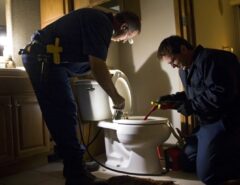Many homes and businesses use on-site wastewater treatment systems called septic systems. These systems consist of a septic tank, a drain field, and piping that connects them all.
Maintaining these systems requires careful planning. Keeping track of inspection histories and scheduling recurring maintenance will prevent costly issues in the future.
Drain Field
For your septic system to work appropriately, solid waste must settle within the tank, and liquid wastewater must be absorbed into the soil. The drain field – the absorption field or leach field – comprises a network of perforated pipes, trenches, gravel, and soil.
The effluent trickles through the drain field and is filtered naturally by the soil and groundwater aquifer beneath. However, if the septic tank is overloaded with solid waste or the drain field becomes saturated with water, the soil can become contaminated, and the effluent may seep into wells used by homes or other areas of the property, causing health issues for people and animals that come in contact with it.
It’s essential to understand how the septic system works, what signs indicate a problem with the drain field, and the best way to prevent septic tank and drain field failure. Septic system professionals can help you keep your septic tank, drain field, and leach lines in good working condition by providing regular maintenance, identifying any issues, and addressing septic system repair as they arise.
Septic Tank
A septic tank is located underground that purifies sewage by separating it through decantation and sedimentation. Septic systems are popular in rural areas that don’t have a centralized sewer network. Wastewater enters septic tanks from household drains and exits through perforated pipes extending into the soil. The inlet and outlet pipes should have acid-resistant concrete, fiberglass, or high-density polyethylene. Baffles or sanitary tees should cover these pipes and have inspection ports on the tops so you can check solids and scum levels.
If your septic system has strong odors, you may have a venting or plumbing problem. Consult a professional to clear plugged vents or enlarge undersized ones. You should also avoid flushing cooking oil, non-flushable wipes, feminine hygiene products, cat litter, cigarette butts, or paint and turpentine down the drains. These can kill the organisms in your septic system that digest and treat sewage. Instead, use water conservation devices like low-flush toilets and faucet aerators.
Installation
A septic system can last for decades if properly installed and maintained. It is more cost-efficient than paying for city sewer services. However, the initial setup can be expensive. To reduce the upfront costs, homeowners can purchase septic tank warranties.
A standard septic system consists of three parts: the sewer drain from the house, the septic tank, and the soil absorption field, also known as the leach field. The house sewer drain and septic tank collect all household wastewater and separate solids from liquids. The septic tank uses natural bacteria to digest the solids and floatable debris like oils and grease. The filtered liquid waste flows into the leach field.
The septic system removes disease-causing bacteria, viruses, and nutrients from household wastewater. This prevents contamination of healthy water and nearby surface waters. Properly functioning septic systems are healthier and more environmentally friendly than sewer systems.
Tags: aerobic septic system repair near me, septic system repair near me, septic systems repair near me




Leave a Reply